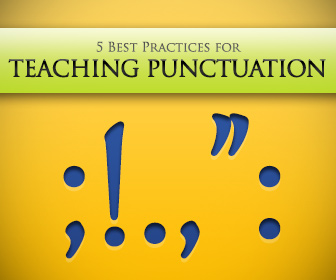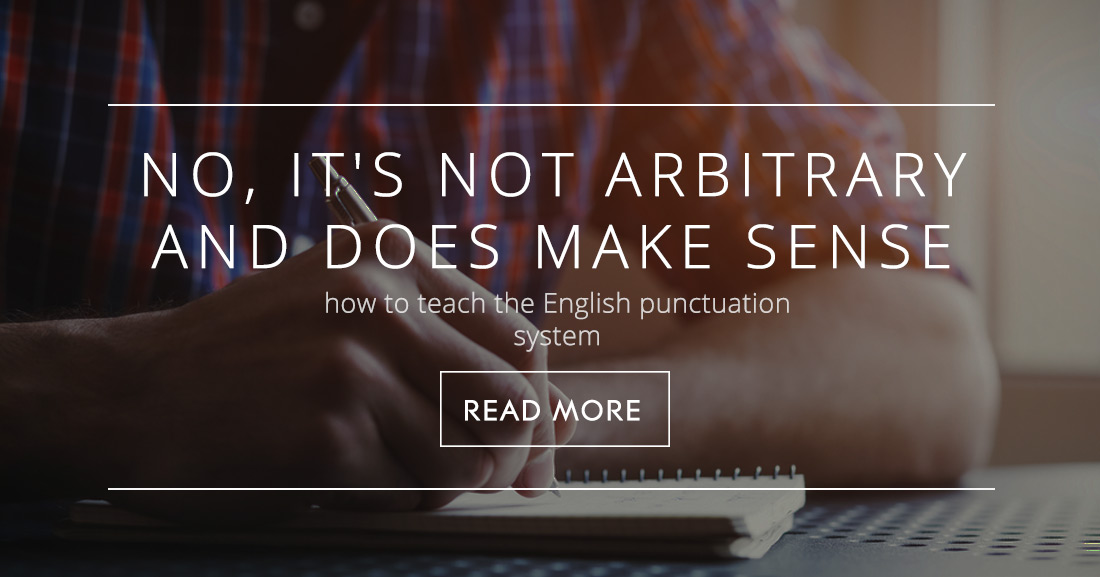How to Teach Punctuation Skills: 5 Best Practices


You might also try putting a period at the end of a “thought.” And what about semi-colons and colons? Well…maybe those are for exceptionally long breaths and thoughts? Okay, I guess you can see that these are no official “Strunk and White” rules about usage but rather the kind of myths about standard punctuation that are perpetuated, sometimes by educators, I’m afraid. Add to this the concern that writers, such as novelist and poets, often employ their own creative punctuation: for example, poet e.e. cummings wrote in all lower-case; popular novelist Stephen King, a former English teacher, writes long, run-on sentences to indicate stream-of-consciousness thought. So by the time students come onto a college campus, they’re often under the impression that punctuation doesn’t matter, or is arbitrary, and makes no sense—sometimes all three. Teaching students standard punctuation is usually a semester-long odyssey that involves first disabusing them of “punctuation myths” they have been exposed to.

Punctuation marks are so important because they guide readers to understand the meaning of the text. And, because punctuation, or a lack of punctuation, can give the text a completely different meaning, students often struggle with reading and writing without a foundation and understanding of this concept.
I’ll stop short of saying telling students “Forget everything you learned before about punctuation,” but I think a good starting place is finding out what students already know. I take a quick inventory, “What does a comma do?”or “Who knows what a semi-colon does?” Students’ answers rarely involve dependent and independent clauses but rather breaths and thoughts and other unquantifiable items. I’ll then ask “So how much of a breath before I write a comma? A short one or long one? Or do both get commas after?” Student laughter indicates that they are starting to see how nebulous these “rules” are.
Another way of exposing these past beliefs on punctuation is to have students take a short questionnaire, with questions like the following, mixing in actual punctuation rules with the myths.
| 1. | You write a comma when you take a breath. | T | F |
| 2. | You write a colon before a list. | T | F |
| 3. | You write a period after a thought. | T | F |
| 4. | A letter S should always have an apostrophe before it. | T | F |
| 5. | A period should be written after an independent clause. | T | F |
| 6. | “Mother” and other important words should always be capitalized. | T | F |
Seeing their beliefs on punctuation “exposed” in black and white print sometimes gets students laughing, which is good because it shows they understand the silliness of the rules they were taught in the past--with all good intention, probably: it’s much easier to talk to a third grader about breaths than about clauses.
Going over these myths can also give students a good laugh, not a bad thing when discussing the dry topic of punctuation.
Students can’t really understand punctuation without understanding basic sentence structure because punctuation connects different parts of the English sentence.
Sentence: A simple sentence is also known as an independent clause. It has a subject, verb, and a complete idea: for example, I drive. This is an acceptable English sentence with a subject (I), a verb (drive) and a complete idea, I drive, meaning I drive every day or habitually; I know how to drive, etc.
Dependent clause: It must be attached to an independent clause for correctness. It has a subject and a verb but is not a complete idea. Because I drive This is not a complete sentence but a dependent clause, and if a student puts a period after it, I will mark it (F) for fragment.
Dependent clauses need to be attached to independent clauses with a comma after if the dependent clause is first
Because I drive, I have car insurance.
Or no comma if the dependent clause is second
I have car insurance because I drive.
I also teach run-ons at this point as the running together of two or more independent clauses without the correct punctuation:
I drive I have a car and I like it a lot
Working with the students, I revise the above sentences with periods and commas:
I drive. I have a car, and I like it a lot.
Or even, if some students know the semi-colon:
I drive; I have a car, and I like it a lot.
Now that some basic sentence structure has been discussed, and students have some understanding of it, punctuation can be delved into more deeply. I usually give a handout of the punctuation mark, a name, a definition and what the mark does, and an example of its use. Introducing punctuation this way emphasizes that it is a system with logical and consistent rules.
, =comma. Separates two independent clauses with a conjunction or separates items in a list
I have studied on this campus for three years, and I have learned a lot.
This semester I am taking Spanish, Algebra, and English.
; =semi-colon. Separates two independent clauses
I have taught here for ten years; I like the campus very much.
: =colon. Placed after an independent clause and before a list
On the day of the final, please bring with you the following items: a pen, a pencil, an eraser, and an exam book.
. =period. Placed at the end of a sentence
Danielle is returning to France for the winter break.
Follow up activities can include reading a few paragraphs out of the course textbook and discussing punctuation decisions the writer made; proofreading a sample paper as an exercise, focusing on the punctuation, and then moving on to proofread their own and their peers’ work.
Students can practice punctuation skills with fun worksheets that include quizzes, games, and songs. They can listen to their favorite songs and find the breaths (punctuation marks) found in the lyrics. A Punctuation Dictionary will also help students to research and to become familiar through working with other resources. And this Grammar, Punctuation and Spelling Dictionary will help make learning punctuation and grammar fun for young learners.
Do you teach punctuation? How do you teach it?